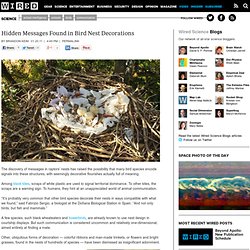

Ants subterranean structures revealed!!!!?! Hidden Messages Found in Bird Nest Decorations. The discovery of messages in raptors’ nests has raised the possibility that many bird species encode signals into these structures, with seemingly decorative flourishes actually full of meaning.

Among black kites, scraps of white plastic are used to signal territorial dominance. To other kites, the scraps are a warning sign. To humans, they hint at an unappreciated world of animal communication. “It’s probably very common that other bird species decorate their nests in ways compatible with what we found,” said Fabrizio Sergio, a biologist at the Doñana Biological Station in Spain. “And not only birds, but fish and mammals.”
A few species, such black wheateaters and bowerbirds, are already known to use nest design in courtship displays. Other, ubiquitous forms of decoration — colorful ribbons and man-made trinkets, or flowers and bright grasses, found in the nests of hundreds of species — have been dismissed as insignificant adornment. Images: 1) Black kite nest. See Also: Mutant Worms Produce Piles of Spider Silk. Snippets of spider genes let mutant silkworms spin silk stronger than steel.

Scientists have coaxed miles of spider-like silk from a colony of transgenic silkworms, opening the door for large-scale production of super-strong, tough and flexible fibers. “We can make a lot more silk from the silkworm process than you could possibly make from spiders,” said molecular biologist Malcolm Fraser of the University of Notre Dame. Spider silk has long been hailed as a superfiber, useful for everything from surgical sutures to bulletproof vests to scaffolding for growing cartilage. But spiders tend to be predatory loners who turn to cannibalism when raised in close quarters, making it nearly impossible to mass produce the treasured threads. A tapestry on display at the American Museum of Natural History last year took more than a million spiders to produce. So scientists have tried to pull spider silk from tobacco plants, bacteria and even goats, with mixed success.
Images: University of Notre Dame. Marc Bekoff: Animal Minds and the Foible of Human Exceptionalism. "Man in his arrogance thinks of himself a great work, worthy the interposition of a deity.

[Yet it is] more humble and, I believe, true to consider him created from animals. " (Charles Darwin, The Descent of Man) Nonhuman animals (animals) are magnificent and amazing beings. They clearly have wide-ranging cognitive, emotional, and moral capacities. We can learn a lot from them if we open or minds and hearts to who (not what) they really are. When we say animals are conscious and smart we mean they know what to do to adapt to ever-changing environments. There are sound biological reasons for recognizing animals as conscious beings. The ramifications of how we view other animals in relation to ourselves are wide-ranging and greatly influence how we treat them.
Clearly, we need to rethink human "uniqueness" and dispense with speciesism. Alienating ourselves from other animals and dominating them is not what it means to be human. We are a significant force in nature. Monkeys See Selves in Mirror, Open a Barrel of Questions. Monkeys may possess cognitive abilities once thought unique to humans, raising questions about the nature of animal awareness and our ability to measure it.

In the lab of University of Wisconsin neuroscientist Luis Populin, five rhesus macaques seem to recognize their own reflections in a mirror. Monkeys weren’t supposed to do this. “We thought these subjects didn’t have this ability. The indications are that if you fail the mark test, you’re not self-aware. This opens up a whole field of possibilities,” Populin said. Populin doesn’t usually study monkey self-awareness. So-called mirror self-recognition is thought to indicate self-awareness, which is required to understand selfhood in others, and ultimately to be empathic.
It was once thought that only humans could pass the mark test. Indeed, macaques — including those in Populin’s study — have repeatedly failed the mark test. Marino, who helped demonstrate self-recognition in bottlenose dolphins, disagreed with Gallup. See Also: